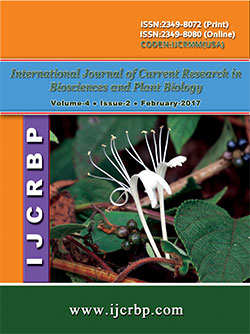 |
Online ISSN : 2349-8080 Issues : 12 per year Publisher : Excellent Publishers Email : editorinchiefijcrbp@gmail.com |
This paper deals with 47 species of Coleopterans, belonging to 37 genera, distributed over 11 families, are associated with different kinds of fruit plantations, occurring in vast localities and areas of Jammu, Kashmir and Ladakh regions. The drupaceous fruit crops (stone, nut, ber), pome (apple, pear quince), berries and aggregate, have been found to be infested with 26 spp., 21 spp., 9 spp. and 1 sp. of Coleopterans under different families respectively. The apple fruit trees /crops (Malus domestica), showed highest number of Coleopteran species i.e., 21, belonging to 8 families. This accounts for 44.68% of total Coleopteran-fauna of this region studied. This is followed by nut fruit crop (Juglans regia), with 12 spp. of Coleopterans species, accounts for 25.53% of total Coleopteran species of horticultural importance. The Scarabaeidae is found to be dominant family, having 15 spp., infesting diverse fruit plantations. This family in dominance is followed by Curculionidae, having 10 species damaging fruit plantations of J & K State. An up-to-date annotated systematic Check list has been provided. Besides this, information on biodiversity has also been given.
